An introduction to the Integrated Voltage Regulator
What is an Integrated Voltage Regulator (IVR)?
An Integrated Voltage Regulator (IVR) is a high-performance power management device designed to provide performance, efficiency, size, and cost benefits to energy-hungry, data-intensive, electronics applications by replacing the traditional power management integrated circuit (PMIC) solutions with a single tiny IC.
The need to provide, amongst other functions, input and output filtering, circuit protection, configurability and compensation for feedback loops means that conventional voltage regulator PMICs have to be combined with additional bulky capacitors, resistors and inductors. This is no longer the case thanks to Empower’s fully integrated voltage regulator, the first and only IVR.
The IVR is a quantum leap over traditional PMIC solutions because it combines a switching voltage regulator with all necessary control and filtering circuitry into a single packaged device, and it eliminates the need for ANY external components.
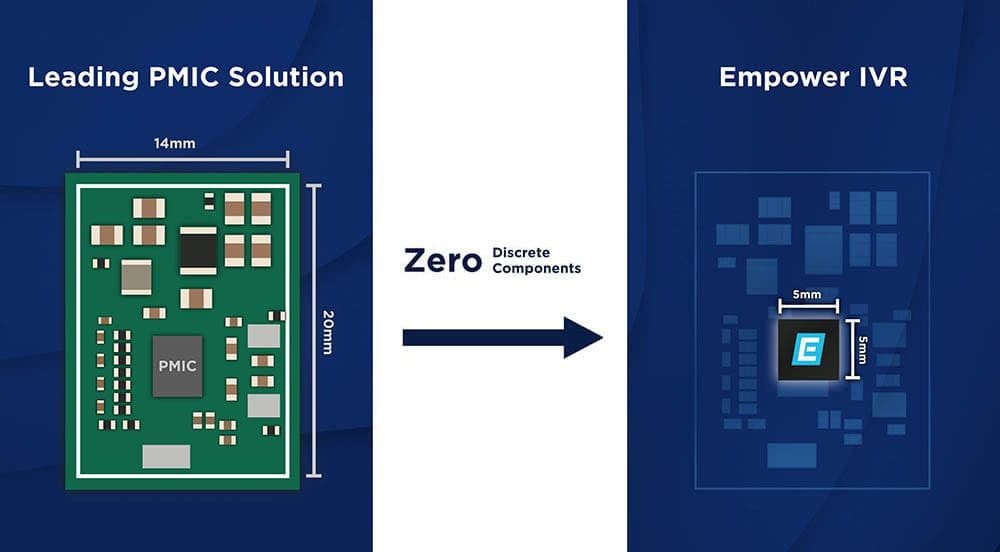
IVRs integrate previously disparate components into a single, compact device
Why do we need IVRs?
IVRs are becoming increasingly important as engineers seek to address the challenge of improving system performance and functionality while simultaneously increasing efficiency and power density. This is particularly true in data-intensive applications such as data center and AI systems that require servers, switches, routers, adapter cards, storage, wireless connectivity and optical transceivers.
As well as offering benefits in terms of operating costs and system size, system efficiency has risen to the top of the design agenda as the world looks for ways to address a growing global demand for electricity at the same time as driving down carbon emissions.
By offering as much as 50% system energy savings over traditional designs, IVRs are uniquely positioned to make a significant contribution to addressing the aggressive system-level efficiency targets needed to meet these goals.
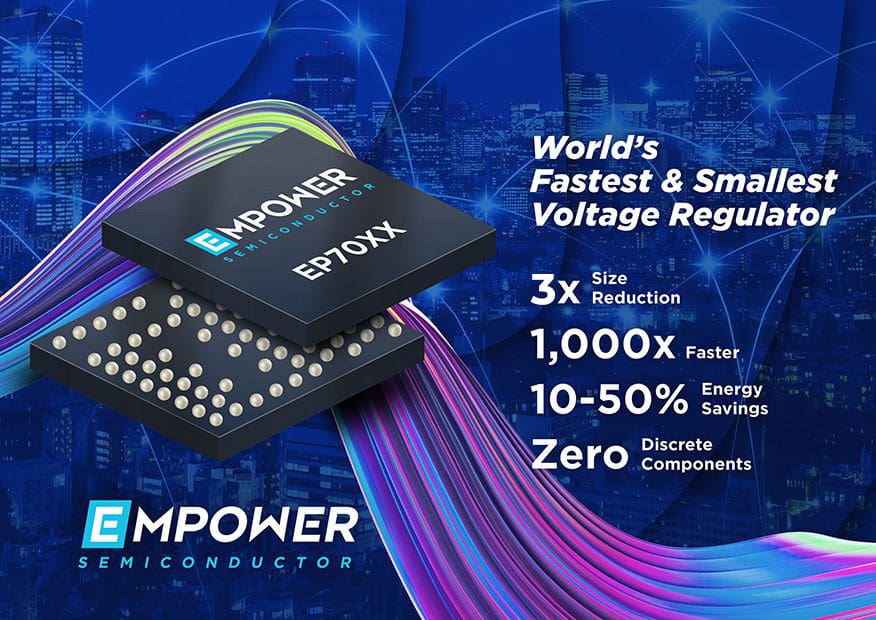
IVRs offer up to 3 times size reduction and up to 50% energy savings compared to traditional designs
As well as dramatically improving system power performance (such as load step response and DVS), IVRs give engineers significant design flexibility by dramatically simplifying the design and implementation of voltage regulation circuitry.
Further benefits accrue from improved application reliability thanks to a smaller number of connections, reduced susceptibility to EMI, a minimized bill of materials and dramatic reduction in PCB footprints.
IVRs and Efficiency #1 - Transient Response
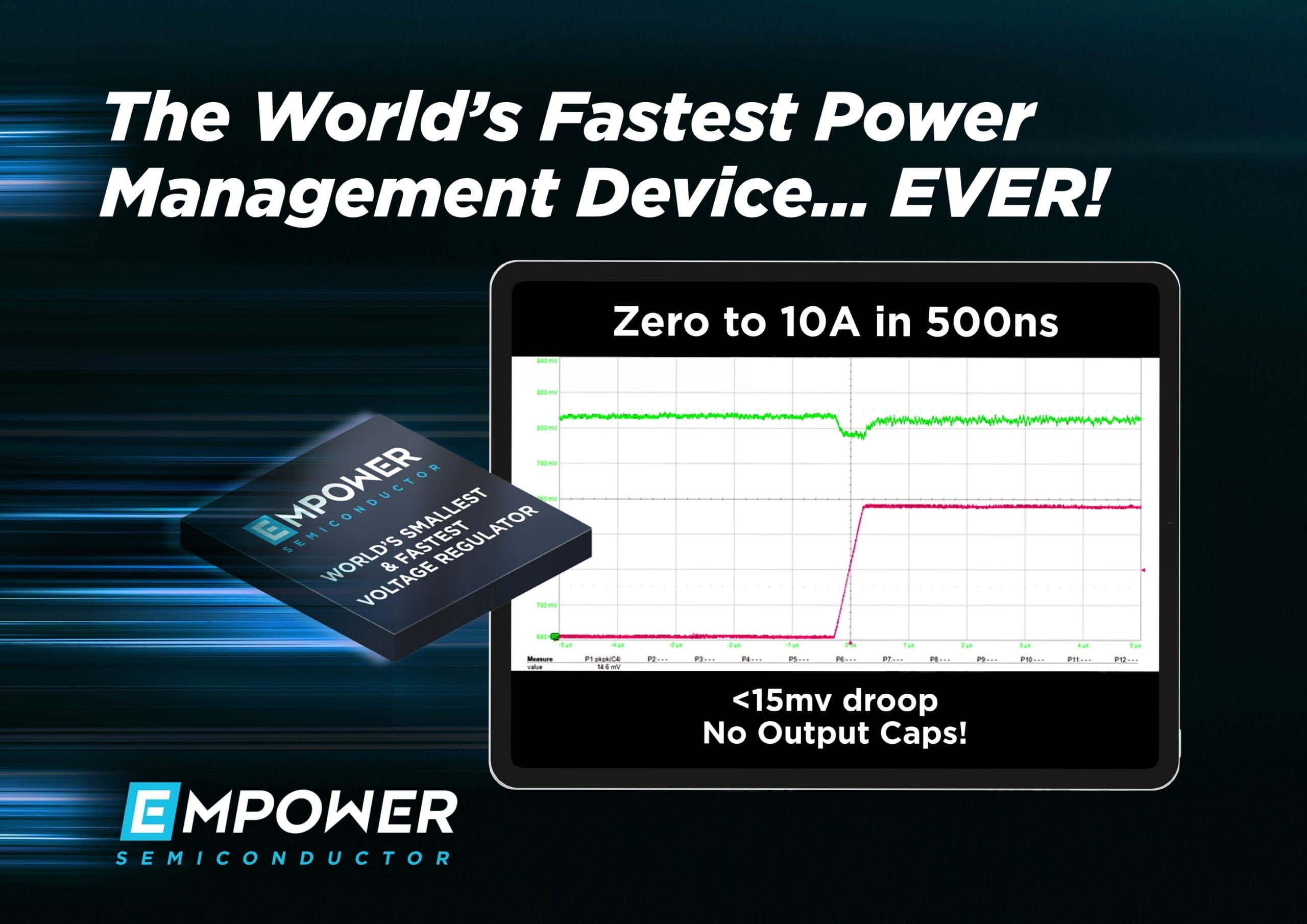
The latest IVRs can offer regulation through a load step from zero to 10A in just 500ns
The load transient response of a regulator is key to any operation for data-intensive applications. As system performances improve and processor speeds continue to rise many existing PMICs are too slow to react to rapidly changing loads, and to return to steady state voltage after a transient.
Because power is proportional to voltage squared, the larger the voltage excursion and the longer the time that is taken to return from the excess voltage condition to the regulated voltage, the more energy is wasted.
IVRs are helping engineers to address this problem thanks to a combination of high levels of integration and proprietary control techniques. Some of the latest devices can deliver tight voltage regulation through ultra-fast transients and offer settling times that are up to one hundred times shorter than those of traditional regulators – and all without the need for additional capacitors.
IVRs and Efficiency #2 – Dynamic Voltage Scaling (DVS)
Another important contribution to system efficiency derives from how the IVR handles dynamic voltage scaling (DVS). DVS is a system power management technique that in real-time optimizes the supply voltage to minimize losses based on supplying the lowest possible voltage for operation at a given time.
With DVS as much as 1000 times faster than conventional designs, new generations of IVRs enable fast and lossless processor power state changes in nanoseconds. Nearly instantaneous voltage delivery eliminates excess voltage and, thus, wasted power.
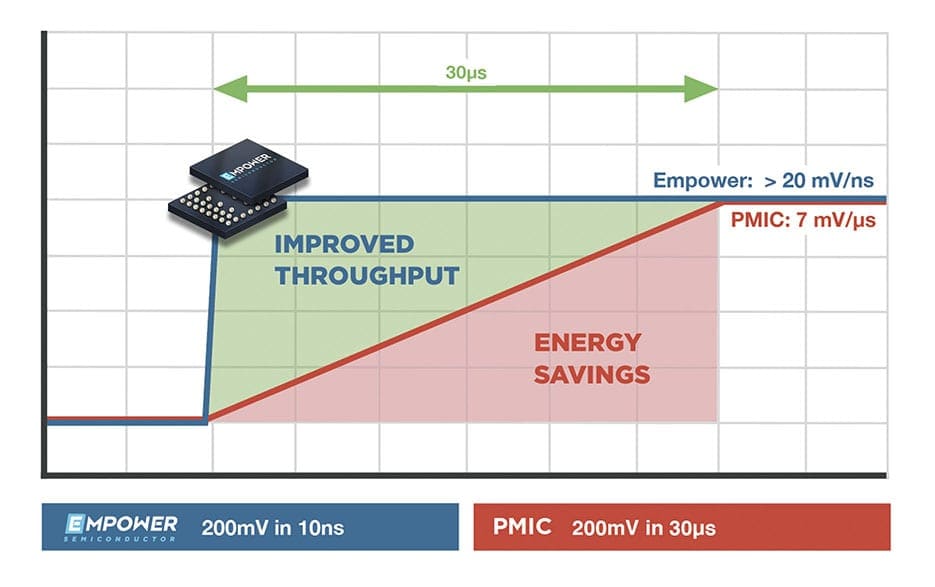
The result is dramatically improved efficiencies when controlling CPUs, GPUs and any other fast, clock-driven digital silicon. This is because nearly all of these components use power states (frequency-voltage combinations) that seek to minimize power-per-operation. ExpressV™ DVS not only removes wasted power on state transitions, but also allows the system to forego the vagaries of having to predict future operating commands in determining the correct power state.
IVRs and Efficiency #3 – Integration
The tiny die size and integration capability of the IVR enable it to be coupled very closely to the digital load. The IVR die solution footprint is small enough to be mounted directly onto a substrate within the SoC itself. Furthermore, the die thickness can be as little as 100um to enable mounting on the bottom side of a substrate to fit within the height of a BGA.
By integrating the IVR in a die solution the close coupling of the load not only eliminates the I2R losses, but it also eliminates the need for large banks of decoupling capacitors. This capability increases the system efficiency while further reducing the number of components and overall system cost.
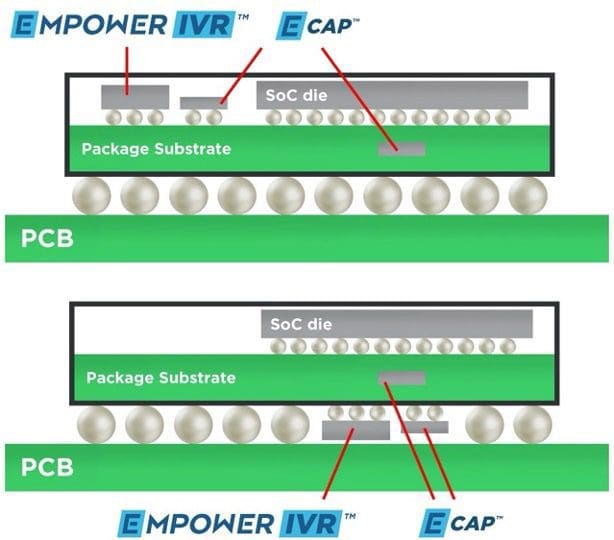
The overall system savings is dramatic when considering the significant reduction in board space while capitalizing on the performance benefits. Efficiency can be maximized while features such as ExpressDVS and the incredible load transient can enable system performance features not possible before.
IVRs and the Data Center – An Example
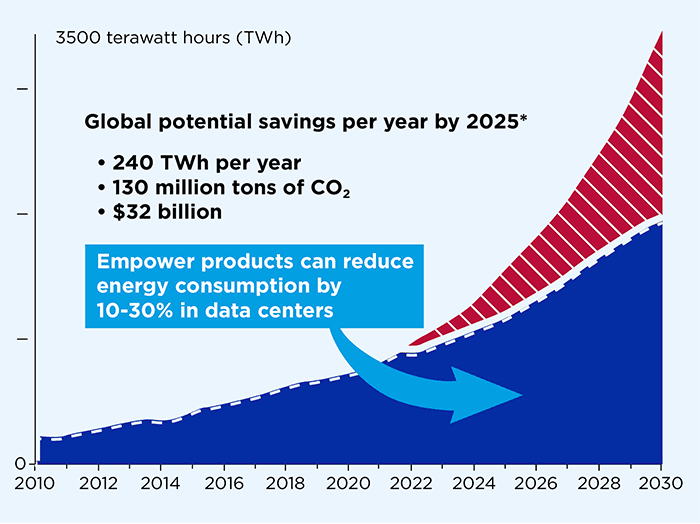
Image shows the potential energy, CO2 and cost reductions of adopting IVRs in data center applications
A good example of the efficiency improvements that IVRs make possible can be seen by considering their use in data center equipment. Adopting IVRs in the processor and memory power management circuitry of high-end servers and storage devices, for example, can help to reduce data center energy consumption by as much as 30%.
If this power saving were to be achieved across the world’s data centers that would equate to an annual power saving of 240 TWh and a reduction in CO2 emissions of around 130 million tons.
Empower Fully Integrated IVR Technology
Built on an advanced CMOS geometry platform and using patented digitally configurable resonant technology, Empower’s EP70XX step-down IVRs are the world’s fastest and smallest switching regulators. Each device can operate directly from a 1.8V input supply or as the second stage of a two-stage conversion topology.
EP70XX IVRs are available with single-, dual- or triple-regulated outputs and integrate all of the discrete components needed for a complete power supply in a single, compact chip-scale BGA package with dimensions of just 5mm x 5mm. This makes them up to ten times smaller than more conventional voltage regulation circuits built around discrete semiconductors and passive components.

IVR brings together FET, control circuits, passives and magnetics in a single IC
Devices in the family display peak efficiencies of up to 92% with nearly flat efficiency curves across varying loads, and can regulate through a load step from zero up to 10A of output current in just 500ns with under 15mV voltage excursions.
All of the members of the EP70XX family provide higher accuracy during full-scale and extremely fast transients and settling times that are up to 100 times faster than those possible with conventional designs. This is because traditional converters must operate at low frequencies (0.3MHz to 3MHZ) to achieve high efficiency, necessitating several large capacitors for output and input filtering if they are to achieve reasonable transient response. Eliminating these large capacitors allows the Empower IVR’s output voltage to drop by one third or less with recovery times one hundred times faster than today’s best-in-class DC/DC converters.

Empower IVR products also exhibit ExpressV™ DVS, an ultra-fast and programmable DVS at up to 12mV/ns is over one thousand times faster than that available from conventional technologies. As a result, these devices enable processor power state changes in nanoseconds.